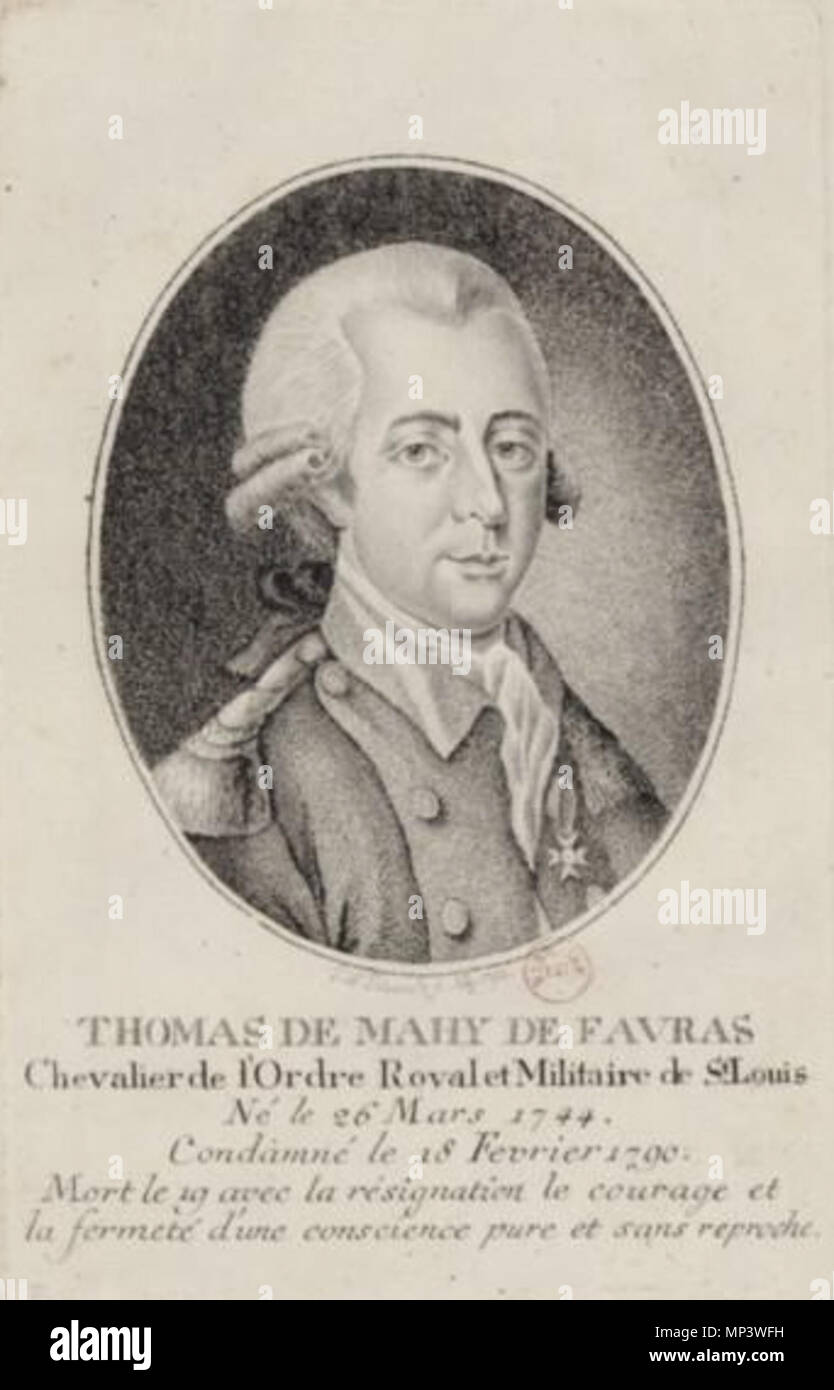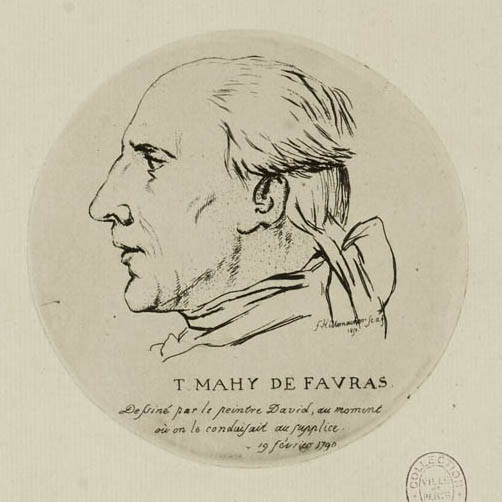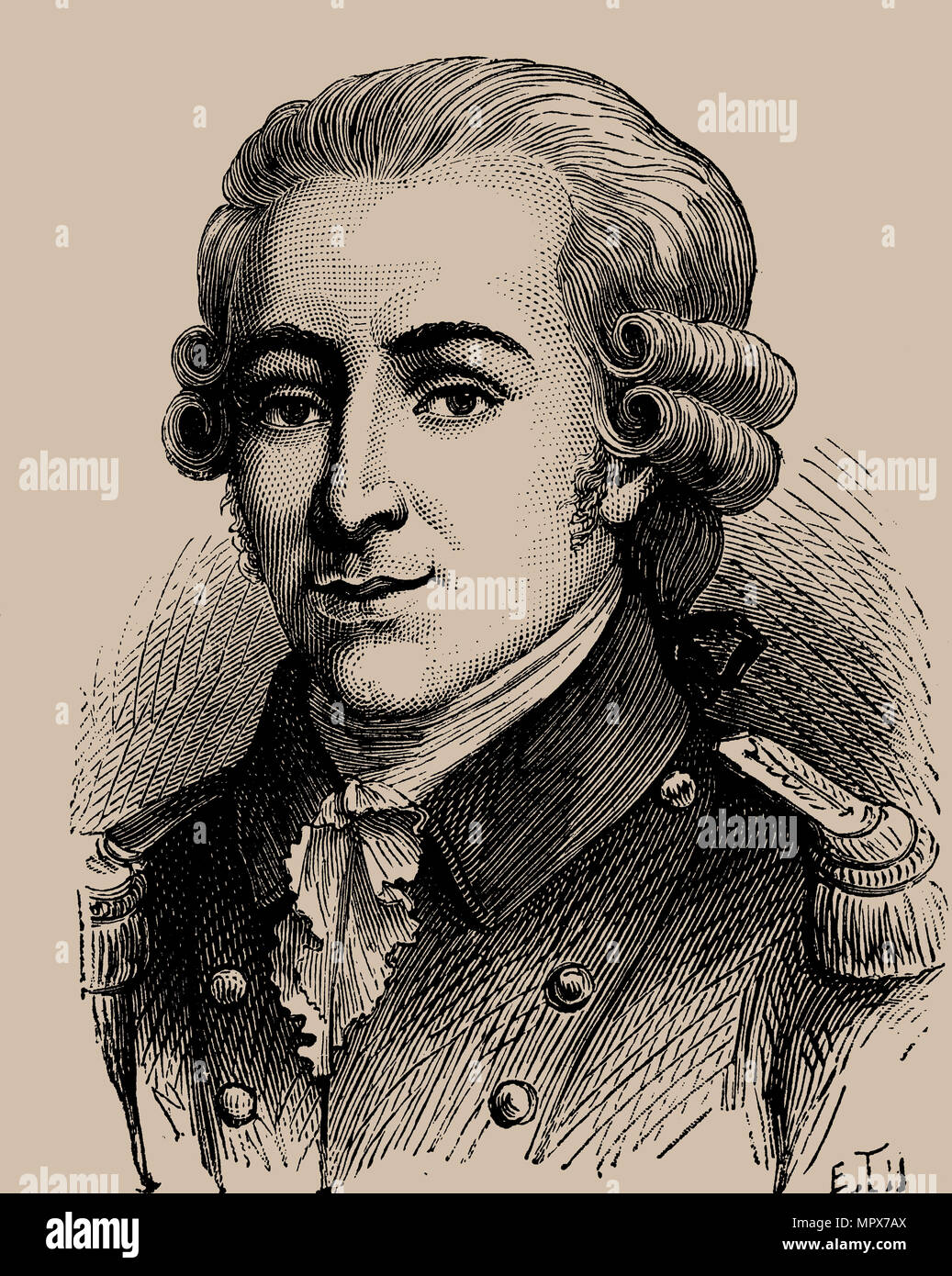
Image result for marquis de favras History Memes, History Facts, Weird Facts, Fun Facts, Haha
In December 1789, the marquis de Favras planned to kidnap the king and take him to the safety of the fortress at Metz. However, Favras roused the suspicions of Lafayette, who had him watched. The plot was uncovered and Favras was hanged in February 1790. Yet that was not the last of the attempts to remove Louis from Paris.
Portrait de Mr le marquis de Favras extrait du Journal de Paris le 20 fevrier 1790. Avant d
The Marquis de Favras (Palace Royale) was taken up, with the Marchioness, his lady, the night between the 24th and 25th on account of a plot formed by him for making 30,000 men rise up in arms, for murdering the Marq. de la Fayette and the Mayor of Paris, and afterwards of cutting off our supplies of provisions..

Exécution du marquis de Favras 19 février 1790. Paris Musées
FAVRAS, THOMAS DE MAHY, Marquis de (1744-1790), French royalist, was born on the 26th of March 1744, at Blois. He belonged to a poor family whose nobility dated from the 12th century. At seventeen he was a captain of dragoons, and saw some service in the closing campaign of the Seven Years' War. In 1772 he became first lieutenant of the.

Marquis De Favras Net Worth, Age, Height & Wiki
Exhibitions and events Collection Toggle Collection submenu Back to previous menu — Collection — Collection — Collection online — Galleries — Blog — The British Museum podcast

De mahy de favras hires stock photography and images Alamy
Genealogy for Thomas de Mahy de Favras, 1776 Marquis (1744 - 1790) family tree on Geni, with over 230 million profiles of ancestors and living relatives. People Projects Discussions Surnames

The Execution of Thomas de Mahy, Marquis de Favras (17441790), February 18, 1790. Museum
Born in Favras near Blois in 1745 to a very old and noble family, Marquis de Favras was a passionate royalist who served in the army with distinction. His professional career included being a captain of dragoons in the Seven Years' War closing campaign and serving the Comte de Provence, Louis XVI's brother, as a first lieutenant in the.

Thomas de Mahy, marquis de Favras (17441790) Images d’Art
Thomas de Mahy, Marquis de Favras (26 March 1744 - 18 February 1790), was a French aristocrat and supporter of the House of Bourbon during the French Revolution. Often seen as a martyr of the Royalist cause, Favras was executed for his part in "planning against the people of France" under the Count of Provence.

Marquis de Favras Personnages Parcours Révolution
Thomas de Mahy, marquis de Favras, chevalier de l'ordre de Saint-Louis, né au château de Favras , près de Blois, le 26 mars 1744, pendu à Paris le 19 février 1790, est un militaire et gentilhomme français, premier lieutenant de la garde du comte de Provence et soutien de la cause royaliste durant la Révolution française. Il est connu.

Detail d'une conspiration forme e contre le roi & la patrie, par M. le Marquis de Favras, chef
On this date in 1790, Thomas de Mahy, Marquis de Favras, became a penal milestone: the first French noble executed without class distinction from commoners. At least he made history. The scion of an ancient and penurious noble line, Favras was trying to make a different kind of history: he'd hitched onto a plot of the future Louis XVIII to.
Rodama a blog of 18thcentury & Revolutionary France The Marquis de Favras courageous
The Marquis de Favras was caught by the radicals of the French Revolution as he plotted to help Louis XVI escape. Thomas de Mahy, marquis de Favras (1744-1790) - The Book of Threes On his deathbed his last words were - "I see that you have made three spelling mistakes."

École Française du XVIIIe siècle, de Mesgrigny ? Portrait présumé du marquis de Favras. Crayon
February 19th: The Marquis de Favras is found guilty of plotting to organise an armed force, rescue the king and initiate a royalist counter-revolution. He is executed by hanging.. Jacobins and Cordeliers rally on the Champ de Mars, to construct a petition calling for the abolition of the monarchy. The National Guard opens fire on a rowdy.

» 1790 Thomas de Mahy, Marquis de Favras
Portrait of Thomas de Mahy, Marquis of Favras (1744-1790) Favras, Thomas de Mahy, otherwise known as the Marquis of: Born into an old noble family, he was initially sympathetic to the ideas of liberty defended by those who were called patriots during the Enlightenment. However, when the Revolution broke out in France, he immediately opposed.
Engraving_from_the_end_o_-_(MeisterDrucke-1047096).jpg)
Thomas de Mahy, Marquis de Favras (17441790)のポートレート。
On 4 February 1790, the Marquis de Favras was executed for plotting to spirit the King out of France and stage a coup against the Constituent Assembly. The exposure of this plot generated such negative publicity for the crown that after the execution, the King addressed the Constituent Assembly and condemned Favras, declaring his support for.
Le Marquis de Favras convaincu de crime de leze nation, condamné par le chatelet de Paris à
Thomas de Mahy, Marquis de Favras (1744-90) occupies a unique place in the history of early French revolutionary justice. For surprising as it may seem considering the degree of vindictive emotion aroused from the very beginning, this obscure ex-military officer and adventurer who "had more titles than assets" was the only counter-revolutionary conspirator legally executed until after.

Thomas de Mahy, Marquis de Favras (17441790), 1889 Stock Photo Alamy
Thomas de Mahy Favras, marquis de (tômä´ də mäē´ märkē´ də fävräs´), 1744-90, French royalist.After the outbreak of the French Revolution, he plotted (1789) with the comte de La Châtre to steal Louis XVI away to Metz and to proclaim the comte de Provence (later Louis XVIII) regent.The plan allegedly also called for the assassination of Jean Bailly, mayor of Paris, and the.
Execution de Mr le marquis de Favras extrait du Journal de Paris le 20 fevrier 1790. Avant d
The execution of the Marquis de Favras The query should be easy to resolve. Thomas de Mahy, marquis de Favras, was the very first Counter-Revolutionary to be condemned to death: he was hanged (rather than guillotined) in February 1790.